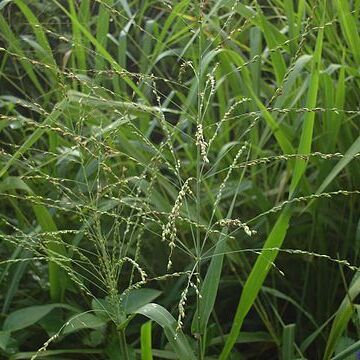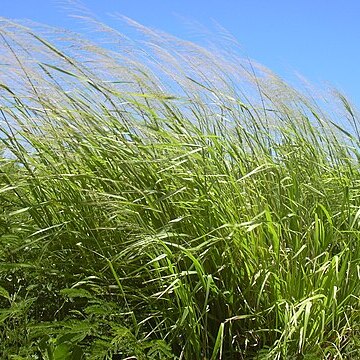Loosely to densely tufted, usually perennial, occasionally annual, up to 2 m high, erect or geniculate and rooting at nodes; usually glabrous or sometimes hispid to pilose. Leaf blade 60-400(-1000) x 4-12(-35) mm; ligule a fimbriate membrane. Inflorescence a (120-)450(-600) mm long panicle, usually much branched, secondary branches well developed and flexuous, glabrous; lowest branches usually arranged in a whorl. Spikelets 2.5-3.0(-4.0) mm long, mostly blunt or acute, dorsiventrally compressed, glabrous or pubescent; lower glume ± 1/3 length of spikelet, 3-nerved; upper glume 5-nerved. Florets 2; lower floret usually male, lemma back rounded, palea well developed, slightly longer than upper floret; upper floret bisexual, lemma indurated, pale, conspicuously transversely rugose, entire, margins only clasping edges of palea. Flowering time Nov.-July.
Loosely to densely tufted, usually perennial, occasionally annual, to 2000 mm high, erect or geniculate, rooting at nodes; usually glabrous, sometimes hispid to pilose. Leaf blade 60-400(-1000) x 4-12(-35) mm. Inflorescence 120-450(-650) mm long, glabrous or pilose below, usually much branched, secondary branches well developed and flexuous, glabrous; lowest branches usually whorled. Spikelet 2.5-3.0(-4.0) mm long, mostly blunt or acute, back rounded; closed spikelet with many nerves clearly visible on lower lemma, cartilaginous, glabrous or hairy; lower glume 1/3-1/2 the spikelet length, 3-nerved; upper glume 5-nerved; lower floret usually male, lemma back rounded, palea well developed, slightly longer than upper floret; upper lemma and palea pale, conspicuously transversely rugose; anthers 1.5-2.0 mm long.
Perennial with stout rhizomes; culms usually in large clumps, 1-2.5 m. high, erect or sometimes geniculate at the lower nodes, the nodes usually densely hirsute; sheaths shorter than the internodes, papillose-hirsute or nearly glabrous; ligule 4-6 mm. long, densely ciliate; blades elongate, 1-2 cm. wide, narrowed toward the base, the margins very scabrous; panicles 20-45 cm. long, the branches ascend-ing or spreading, somewhat drooping at maturity, in rather distant whorls, naked toward the base, pilose in the axils; spikelets 3 mm. long, acute, glabrous, the first glume obtuse, about one-third as long as the spikelet; fruit 2.3-2.5 mm. long, transversely rugose.
Usually perennial or annual (occasionally), loosely to densely tufted (erect and geniculate, rooting at nodes), up to 2 m high. Leaf blades 6-40(-100) mm long, 4-12(-35) mm wide. Spikelets 2.5-3.0(-4.0) mm long. Inflorescence usually much-branched with secondary branches well developed and flexuous; spikelets blunt or acute, rounded on back, cartilaginous; the closed spikelet with many nerves clearly visible on lemma of lower floret; lower floret usually male with palea well developed; female-fertile (upper) lemma pale and conspicuously transversely rugose.
Perennial or occasionally annual; up to 2 m high; loosely to densely tufted. Culms erect; geniculate; rooting at nodes. Leaf blades 6-40(-100) x 4-12(-35) mm. Flowers: panicle open; much branched with secondary branches well developed; flexuous; spikelets 2.5-3.0(-4.0) mm long; spikelets blunt or acute; rounded on back; cartilaginous; closed spikelet with many nerves clearly visible on lemma of lower floret; lower floret usually male with palea well developed; upper female-fertile lemma pale; conspicuously transversely rugose.
A grass. which keeps growing from year to year. It forms tufts. It has short underground stems or rhizomes. It can be 2-3 m tall. The leaf blades are 15-30 cm long. The flower part of the flowering head has side branches in a ring. The flowering head is open and branched. It has a central upright stem. The long thin side branches grow out from this. The flowers are small and oval and 2-3 mm long. They are on small wavy stalks.
Perennial, sometimes annual, up to 2 m tall. Leaves lanceolate; ligule a fringed membrane. Inflorescence an open panicle. Spikelets 2.5-5 mm long, awnless; glumes unequal, lower up to half as long as spikelet, upper 5-nerved; 2-flowered, lower floret male or rarely sterile, soft; upper floret fertile, lemma hard and transversely wrinkled.
Perennial, sometimes annual to 2 m. Leaves lanceolate. Spikelets ± 3 mm long, in an open panicle, purple, secondary branches flexuose, fertile lemma transversely wrinkled.


